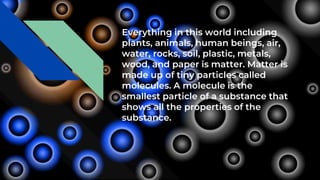
Matter(arrangement of molecules
- 1. Everything in this world including plants, animals, human beings, air, water, rocks, soil, plastic, metals, wood, and paper is matter. Matter is made up of tiny particles called molecules. A molecule is the smallest particle of a substance that shows all the properties of the substance.
- 2. ACTIVITY Take a few sugar crystals and crush them with the help of a rolling pin. The sugar crystals break and form a powder. Observe this powder through a magnifying glass. You will see that this powder is made of even tinier particles. If we keep on breaking a tiny particle further and further, a stage comes where it cannot be divided any further. This tiny particle is a sugar molecule. Each sugar crystal is made up of many such sugar molecules
- 4. PROPERTIES OF MOLECULES Some common properties of molecules are given below. • Molecules are tiny substances that cannot be seen with the naked eyes. • Molecules of different substance have different shape, size, and mass. • Molecules in different substances are arranged differently. • Molecules are made of still smaller units called atoms.
- 7. There are 118 different types of atoms. Atoms of the same or different types combine to form molecules of all the substances around us. For example, two atoms of oxygen combine to form a molecule of the oxygen gas. In a similar way, two atoms of hydrogen combine with one atom of oxygen to form a molecule of water
- 8. Arrangement of molecules in solids, liquids, and gases Solids • In solids, the molecules are closely packed. • There are strong forces of attraction between molecules. These forces hold the molecules together. This gives solids a definite volume. • There are no spaces between molecules to move around. So they cannot move away from one another. This means solids cannot flow. This gives solids a definite shape. Thus solids have a definite shape and size.
- 10. Liquids • In liquids, the molecules are less tightly packed. • There forces of attraction between molecules are not as strong as in solids. However, the forces are strong enough to hold the molecules together. So liquids have a definite volume. • There are spaces between molecules to move around freely. This allows liquids to flow and take the shape of the container they are put in. Thus liquids have a definite volume but no definite shape
- 12. Activity Aim: To understand the arrangement of molecules in solids Things required: Marbles, a glass jar, and sand Method: Take the glass jar and fill it completely with marbles. Close the lid of the jar. Shake the jar and see if the marbles move and change their position. Open the lid and add some sand into the jar. Shake the jar. Shake it and add more sand. What do you notice? Where does the sand go? Observation: You can see empty spaces between the marbles. These spaces are not big enough to allow the marbles to move from their place. However, these spaces are enough to accommodate the sand particles. This is similar to the arrangement of molecules in solids. Sand takes up the intermolecular space, where marbles represent the molecules
- 14. Gases • In gases, the molecules are loosely packed. • The forces of attraction between molecules are very weak. These forces are not able to hold the molecules together. The molecules move quickly in all directions and fill all the available space. So gases do not have a definite volume. • There are large spaces between molecules to move around freely. Thus gases neither have a definite volume nor a definite shape.